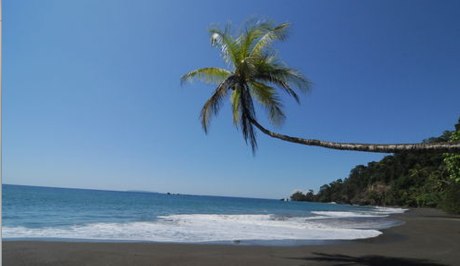The offer:
As part of a publicity push for its carbon-neutral ENVIRONMENT Papers line, Neenah Paper launched a sweepstakes to win an eco-trip for two to the Osa Peninsula in Costa Rica and a chance to “go hard core and experience conservation in the heart of some of nature’s most fragile environments.” The lucky winner is promised the “opportunity to help make the world a better place.” Just your contact details are required to enter.
Neenah is also awarding three $100 gift certificates to randomly chosen participants who take a five-question quiz “designed to test their environmental awareness.”

The glitch:
I can almost hear the light bulbs flicker as marketing conceived the contest. From some height, a trip to an eco-resort connotes care for the environment. The winner’s tour of Neenah’s joint reforestation project to preserve old-growth forests will underscore the company’s commitment to sustainability. And bases will be covered with the purchase of carbon credits to offset trip emissions.
But the train derailed when Neenah’s marketing team split marketing from mission. Because the trip is a publicity ploy dressed in hemp, it has a lot of holes.
Some holes are more superficial; I don’t equate a resort stay to going “hard core” and there’s no explaination of what the “oppportunity to make the world a better place” means for the winner (a carbon-neutral jeep ride through the forest doesn’t cut it). While other holes indicate lack of an authentic commitment to environmental preservation. Most notably, although the contest announcement and microsite are the perfect opportunity for Neenah to talk about its preservation work, there’s no mention beyond the project’s name and partners. I want to know how is Neenah helping preserve this area? What’s the project’s specific goal? How is Neenah evaluating and reporting success?
Finally, the quiz that’s “designed to test environmental awareness,” focuses only on the environmental qualities of Neenah’s ENVIRONMENT paper. That’s not environmental awareness, it’s product knowledge.
What I would do if I ran Neenah’s marketing team:
- Offer more. Instead of paying for two random individuals to stay in a resort, I would offer a group of influencers–students–the chance to compete for the trip by creating awareness campaigns, fundraisers or school projects in support of conservation. Once in Costa Rica (and downgraded to more rustic accommodations) the group of high school or college students would physically contribute to the project, observing firsthand the fragility of the endangered environment.
..
The outcome would be an educated, mobilized and impacted group of individuals who’ve already demonstrated their environental compassion (and raised visibility for my company, Neenah) through their contest submissions. And now, my company has a cohort of people who have been touched by the brand and have internalized the company mission. This cohort of brand evangelists and potential conservationists comes with a network of family, friends, fellow students and teachers–call it a customer base. (I never said it wasn’t marketing). - Undress it. (This is the point on transparency.) I don’t cover marketing and publicity motives in false opportunities to help the world. It’s fine to hold a sweepstakes and offer an eco-trip, but it’s not a valid sustainability initiative. I would call the quiz what it is: questions about the environmental attributes of a new line of paper. Now, not disguised as an environmental awareness quiz, it’s a great tool to promote the product’s sustainable qualities.
- Be explicit. A top rule in cause-related marketing is to be explicit about the program. I would communicate how Neenah is supporting conservation efforts (if with money, how much and for how long), what the company’s intended impact is, what it’s accomplished so far and how it’s measuring success.
- Involve the nonprofit partner. It’s a good move to include your nonprofit partner. It usually means there’s legitimate commitment to an issue. Plus, I can leverage a combined network to promote the program and potentially offload some of the planning and programmatic logistics.
And you? I’ve had fun conceptualizing this campaign, but what would you do differently?





 I'm Olivia Khalili. I created Cause Capitalism to show you how to grow your business by incorporating a social mission.
I'm Olivia Khalili. I created Cause Capitalism to show you how to grow your business by incorporating a social mission. 
